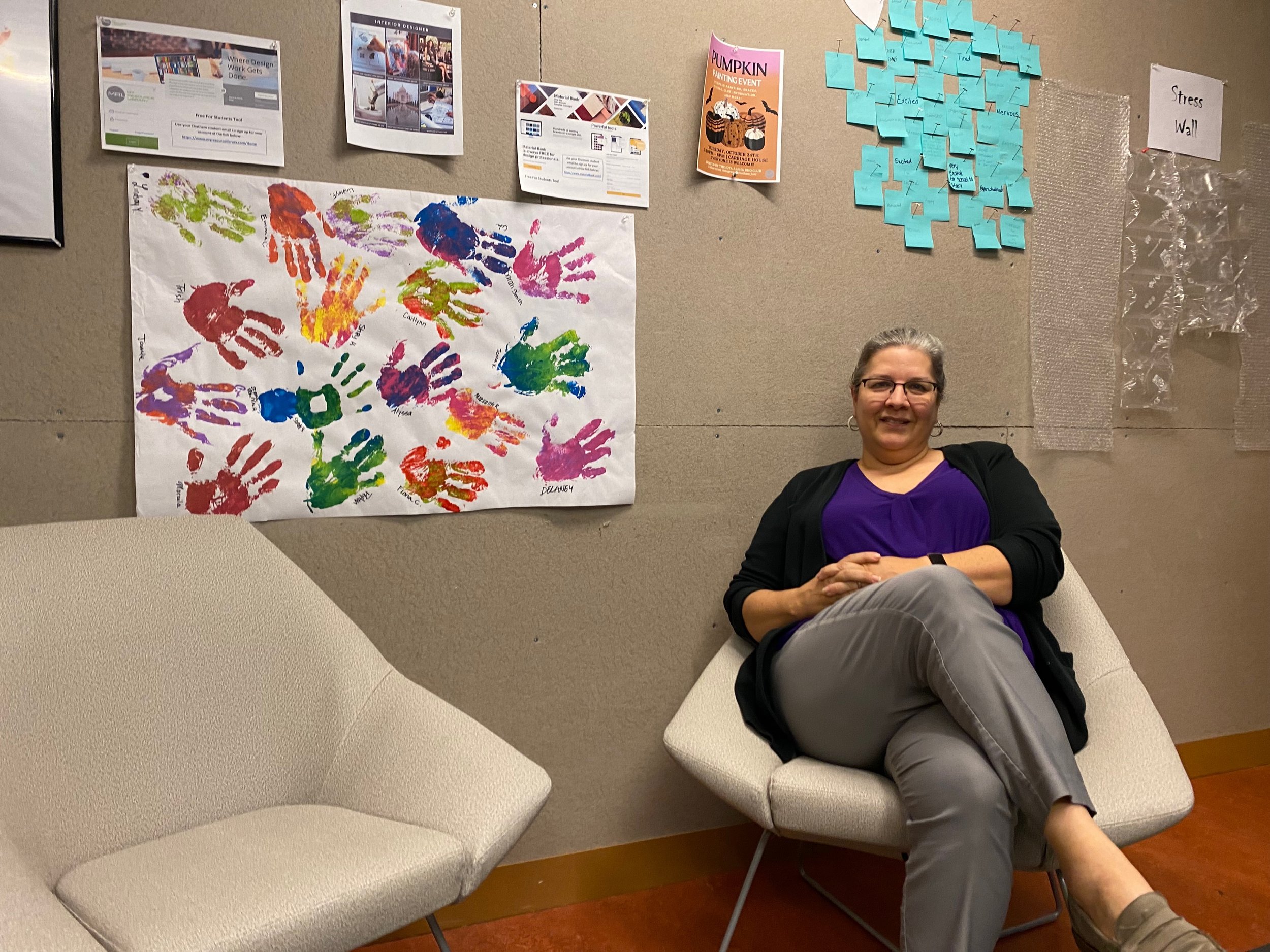“The 3rd Place” Gives Interior Architecture Students a Room to Chill
Dr. Maureen Monhollen, assistant professor at Chatham University, sits for a portrait in The 3rd Place Lounge, a chill-out room she helped design for students at Chatham Eastside. (Mick Stinelli)
Assistant Professor Dr. Maureen Monhollen, Ph.D., saw something change in the class of students that entered Chatham University’s interior architecture program after the onset of the COVID-19 pandemic.
“We noticed a huge influx of mental health accommodation in our students,” Dr. Monhollen said. “We have about 80 students in our undergrad. We had more than 10% of our students with accommodations, which was really concerning.”
A lot of those students reported conditions such as stress, anxiety, and depression. Dr. Monhollen and her colleagues realized students in their program, located on the second floor of Chatham Eastside, didn’t have a place to decompress if they had a panic attack or other sudden mental health crisis.
That’s when she fell back on her research on “third places,” dedicated spaces other than where you live and work (the home and the workplace are respectively known as the first and second place). Common third places include public libraries, churches, parks, cafes, or gyms.
“A third place is where people gather together but alone,” Dr. Monhollen explained. “There’s a lot of people there for a common cause, but not necessarily to meet people or be together.”
After moving the interior architecture program’s collection of journals and other periodicals into a space down the hall, Dr. Monhollen helped design “The 3rd Place Lounge” at Chatham Eastside. “We needed a place where the students could just step away.”
She recalled a specific student with anxiety who sometimes had panic attacks. When the student felt overwhelmed, Dr. Monhollen said, she would sit in her car to calm down because she didn’t feel comfortable anywhere else.
“We’ve seen this kind of behavior with other students as well,” Dr. Monhollen said. “The problem is, once they get into their car, it’s that easy to just leave.”
Click the video above to enlarge the picture and see inside The 3rd Place Lounge.
Chatham Eastside’s “The 3rd Place Lounge” came together with thrift, using a lot of materials the program already had. Rocking chairs, short tables, desks, and other items were placed in the room to give students a place to sit down and relax or work in private. But other items began showing up on their own; Dr. Monhollen furnished the room with just one jigsaw puzzle but was surprised to see several more brought in by students.
“I have no idea where they came from,” she said. “Students would just keep bringing in cool puzzles. Okay!
“And this is the hit of the room,” she said, gesturing to a desk covered by a partially finished jigsaw puzzle and hundreds of loose pieces. “This table is always being used. There’s always at least one or two people, heads down, playing at the table, playing with those puzzles.”
It’s exactly the kind of activity the room was designed to encourage. Doing a puzzle allows students to focus on something fun and slow-paced, rather than diving right back into schoolwork or scrolling endlessly on their phones between classes. While there are also two private desks behind a foldable wooden partition, where students can conduct private study, those workspaces are just as conducive to enjoying a novel or drawing pictures.
Bubble wrap tacked to the wall gives students something to squeeze to release their stress. Notes and artwork done by interior architecture students are all over the room too, showing the sense of community imbued in this small cohort.
Just having a physical space for students to “be,” rather than to “do” any particular thing, has helped them, Dr. Monhollen said. “They say, ‘Ah, it’s so nice to just go in there in chill. The puzzle helps me focus,’” she said. “You just can shut out the world and focus on this.”
Learn more about how design can affect our minds and behavior by exploring Chatham’s Bachelor of Interior Architecture and Master of Interior Architecture degrees.
Mick Stinelli is a writer and digital content strategist at Chatham University. His work has previously appeared in the Pittsburgh Post-Gazette, 90.5 WESA, and WYEP.org.

